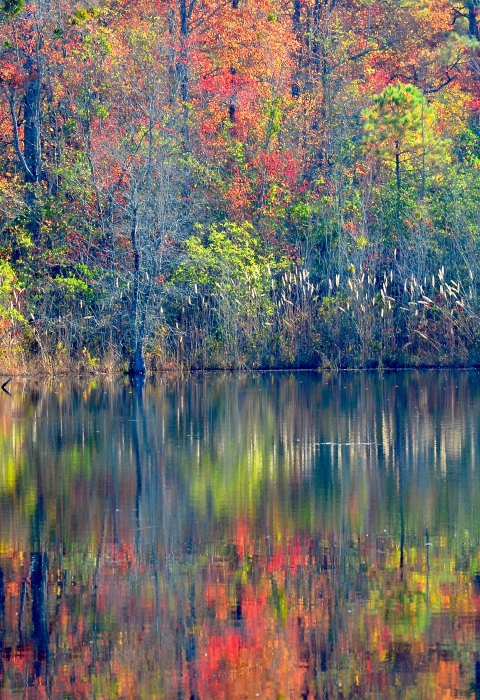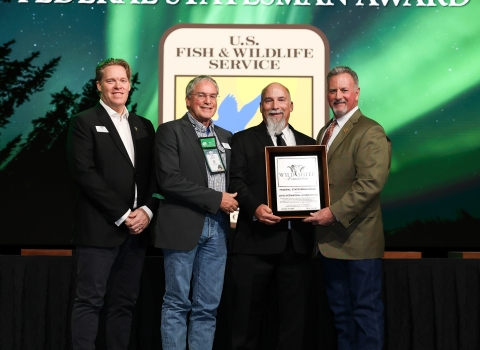Tucked away in the northeast corner of the Palmetto State, just a short drive from the Queen City of Charlotte, North Carolina, residents and visitors of Chesterfield County, South Carolina, will find a crowning jewel for outdoor activities.
Those who visit Carolina Sandhills National Wildlife Refuge can enjoy picnicking, fishing, hiking, hunting, bicycling, non-motorized boating, and wildlife observation and photography. Birders can watch the iconic royalty of endangered birds – the red cockaded woodpecker.
With so many activities to choose from, the almost 50,000-acre refuge is a sanctuary for wildlife and people. Nature lovers can take advantage of the refuge’s six named hiking trails, more than a dozen information kiosks and wayside exhibits, 30 ponds and lakes, 140 miles of earthen and gravel roads, a 10-mile paved wildlife drive, three fishing piers, two observation decks, and a photography blind.
Lyne Askins, refuge manager, says there’s something for everyone.
“The refuge is a haven for wildlife enthusiasts. Visitors have come from as far away as Alaska to see red-cockaded woodpeckers,” she said. “Birders relish the opportunity to see spring migrants and resident breeding birds such as Bachman’s sparrow. Photographers find floral subjects and associated pollinators February through November.”
A former refuge manager at Carolina Sandhills says it’s a pretty special place. Ricky Ingram explains the refuge has tremendous plant and bird diversity for those who love to explore nature and view wildlife. He adds that the refuge offers good deer and turkey hunting and is one of the few places where bobwhite quail can still be hunted. Their majestic calls can be heard in the spring and summer nesting seasons.
“Anyone wanting to get away from the demands and stresses of life to recharge, can get out with easy access by car, bike, or on foot to the quiet and solitude of nature on Carolina Sandhills National Wildlife Refuge to explore and observe a variety of plant and animal species, plus commonly see the rare red-cockaded woodpecker,” Ingram said.
It's all free to the public all year long, and just about any time is a good time to visit. Many gather at Carolina Sandhills for National Fishing and Boating Week. This year, that’s June 3-11. To kick off the festivities, Friends of the Carolina Sandhills National Wildlife Refuge will hold the 16th annual Youth Fishing Day June 1.
“Anglers find solitude when fishing on the refuge and while they may keep their catches, many practice catch and release for the opportunity to return and try for another bite,” Askins adds. “Bicyclists have a safe and quiet, yet challenging place to ride with hundreds of miles of hilly roads.”
This year marks Carolina Sandhills National Wildlife Refuge’s 85th anniversary. While official festivities recognized the refuge’s longleaf pine restoration, endangered species recovery, and natural resources conservation, the main event highlighted increased public access. To celebrate, the staff officially opened a newly designated hiking path, known as Doe Hill Trail. The trail includes interpretive signage along the way to help enhance visitors’ experiences.
While hiking along Doe Hill Trail, the public can enjoy a variety of natural features, including wetlands such as pocosins, Atlantic White Cedar bogs, and canebrakes; upland longleaf pine forest and grasslands; and unique geologic formations of rock outcroppings peeking out of the hillsides. Hikers may also see an array of wildflowers from early spring through late fall including trailing arbutus, pixie moss, and birdfoot violets beginning in February and blazing star, chaffhead, and Pine Barrens gentian in October. In fact, more than 1,000 species have been identified on the refuge.
“Along the trail, visitors will learn about the endangered red-cockaded woodpecker, which has made a remarkable recovery on the refuge,” Askins said. “Alongside towering longleaf pines where the birds nest and forage, lucky hikers may see this curious bird, pecking away around their homes in tree cavities. You might even hear their call, which sounds like a child’s squeaky toy.”
Carolina Sandhills National Wildlife Refuge was established in the railroad town of McBee, South Carolina, on March 17, 1939. Since then, it has provided habitat for migratory birds and wildlife-oriented recreational opportunities for the public. In addition to wildlife, the refuge is a premier spot to view the long-valued longleaf pine.
“The most significant accomplishment of the past 85 years is the restoration of a healthy, functioning longleaf pine forest,” Askins said.
When the refuge was established at the end of the Depression, the government purchased eroded agricultural lands from willing landowners, including property that now makes up Carolina Sandhills National Wildlife Refuge. Once the government procured the land, the Civilian Conservation Corps immediately began planting trees, building roads, and providing infrastructure for public recreation.
“During the 1940s and 1950s, the refuge successfully restocked wildlife species such as beaver, deer, and wild turkey and built several ponds for wildlife and public fishing,” Askins said. “Our commitment to increased public access has been a priority for refuge leadership throughout our 85-year history.”
The visitor center is open Monday through Friday, 7 a.m. - 3:30 p.m. All refuge roads are open to vehicular traffic except those marked otherwise. All areas of the refuge are open to foot traffic except where posted.
Recreational highlights at Carolina Sandhills National Wildlife Refuge include:
Lake Bee Recreation Area: Enjoy fishing, hiking, wildlife observation, and picnicking in this area. Three picnic shelters and dozens of tables, along with restrooms, are available. The lake edge provides good birding. Notable plants and animals found in this area include brown-headed nuthatches, several carnivorous plants, and the rare Pine Barrens tree frog, which may be heard from the Pitcher Plant Overlook on the west end of the lake. Nearby Pool H and Triple Lakes host wood ducks and other waterfowl in appropriate seasons. Lake Bee also serves as a hub for Tate’s Trail, Doe Hill Trail, and nearby Pine Barrens Gentian Trail.
Martin’s Lake Recreation Area: Picnic table, trails, boat ramp, and accessible photo blind and overlook. The lake edges provide excellent conditions for observing wading birds, otters, and small mammals. Hikers can access Tate’s Trail from the parking lot.
Oxpen Recreation Area: Home to white tailed deer, turkey, hawks, waterfowl, and small mammals. It is also a popular fishing area and home to a variety of wildflowers. The seepage bog near Oxpen Lake 1 includes a large population of pitcher plants. An observation deck provides a scenic view. Listen for the characteristic call of the bobwhite quail May through July.
Pool A Recreation Area:
- Woodland Pond Trail - One mile; passes through wetlands, upland pine habitat, and a small open area. Good area for songbirds; terminus connect with Longleaf Pine Interpretive Trail across the Wildlife Drive.
- Longleaf Pine Interpretive Trail - This 1/4 mile trail with interpretive signage focuses on the longleaf pine ecosystem.
- Red-cockaded Woodpecker Viewing Area - April through June, this observation area provides good opportunities for viewing red-cockaded woodpecker nesting and foraging activity. Please minimize disturbance to these endangered birds by staying at least 100 feet from cavity trees. All known activity trees are marked with a white band of paint at eye level. In addition to RCW viewing, this area is an excellent example of the desired future conditions for the longleaf pine ecosystem - open, park-like habitat with multiple ages of longleaf pine and grasses, forbs and wildflowers as groundcover.




